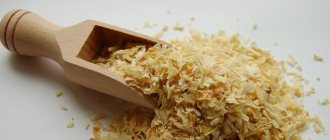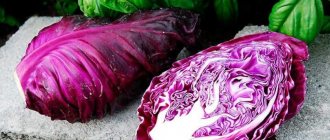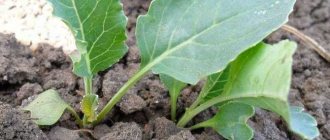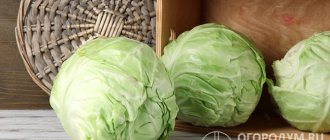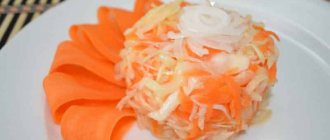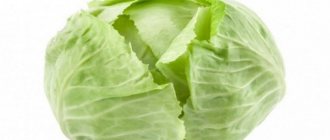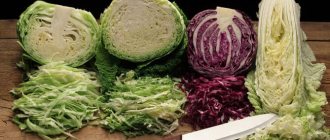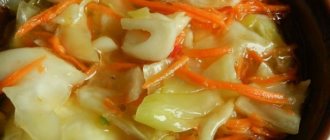Our experience in drying white cabbage Ezidri Ultra FD1000 dryer. The cabbage was peeled from the top leaves and finely grated using a shredder. It turned out: 8.7 kg (87%) - purified product; 1.3 kg (13%) - waste. A mesh or tray was placed in each tray and cabbage was placed on it. 8.7 kg was placed in a thick layer on 20 trays of 440 grams per tray. The norm is 300 grams of cabbage per tray. Since the layer is thick, 8 hours after the start of drying, the cabbage in each tray was stirred for better drying. The cabbage was dried for 16 hours at temperatures of +65-60 °C and room temperature + 5 °C. The Ezidri Ultra dryer consumed 13.8 kW in 16 hours. 8.7 kg of peeled cabbage yielded 800 grams of dried cabbage. Drying 11 times.
Dried cabbage is one of the ingredients for making borscht from dried vegetables.
*****************************************************
White cabbage is a very ancient and useful agricultural crop that has excellent taste and at the same time contains many useful substances. It is consumed in a variety of forms: boiled, fried, stewed, pickled, salted, dried. Cabbage is included in recipes for first and second courses, salads, and pies.
Cabbage has been known since the Bronze and Stone Ages. It has been grown for over 2000 years. Even in Ancient Greece, cabbage was valued for its beneficial properties and nutritional qualities; about ten varieties were known. The southern Slavic tribes also learned about cabbage from Greco-Roman colonists. Presumably, white cabbage appeared on the Mediterranean coast as a result of a mutation of wild mustard. But Transcaucasia, where a cabbage-like plant called “kezhera” grows, also claims a place that can be called its homeland.
Is it possible to dry cabbage?
Drying has different effects on different types of cabbage. Below we will analyze them in detail.
White cabbage
There are no obstacles to drying white and red cabbage. For a person, 100 g of freeze-dried (that is, dried) white cabbage is equivalent to eating 1 kg of fresh cabbage.
Red cabbage is superior to white varieties in the amount of vitamin C and carotene, and therefore brings much more benefits. The dried vegetable can be eaten alone or used as an ingredient in cooking.
Colored
When dried, cauliflower loses most of its nutrients. For it, the best storage method is not drying, but freezing.
However, if desired, you can dry colored ones. Its taste will deteriorate, but not so much that it becomes a significant problem.
Broccoli
If you maintain the temperature correctly, avoiding overheating above +50°C, then dried broccoli will turn out to be a surprisingly tasty and healthy product.
Important! A properly dried vegetable has no expiration date. After sublimation of moisture, dried products can be eaten not only a year later, but also 5-10 years after drying.
Marine
From a biological point of view, seaweed, also known as kelp, is not a relative of any type of cabbage. However, drying is fine for it.
Dried seaweed with kimchi sauce or any other spices is one of the traditional dishes of Japanese and Korean cuisine. Dried spicy kelp under the brand 緑 – “Midori” (translated from Japanese as “light green, the color of the first spring greens”) is one of the popular products in Russian stores, an excellent appetizer before main courses.
How much dried cabbage can you eat per day?
As already mentioned, a freeze-dried product is 10 times higher than a fresh vegetable in terms of the concentration of nutrients in it. And if doctors do not recommend eating more than 200 g of fresh cabbage per day, then, logically, you should not consume more than 20 g of dried cabbage per day. The limitation in the amount of fresh vegetable eaten per day is caused by its ability to provoke bloating. And in this sense, comparing it with a freeze-dried product is not entirely correct.
If you can make salads from fresh cabbage or simply eat cabbage leaves, then the dried vegetable is used exclusively for cooking:
- borscht;
- cabbage soup;
- vegetable soup;
- pickle;
- vegetable stew;
- side dish;
- various cereals (as an additional ingredient), etc.
In this form, the use of the vegetable is limited only by the degree of saturation of a person.
Advantages and disadvantages of this harvesting method
Advantages of drying:
- Almost unlimited shelf life of preparations. If the vegetable is not moldy and all moisture has been removed from it, it can be stored for years.
- No problems with diseases. All affected heads of cabbage are selected and disposed of at the preparation stage. In the future, there is no need to monitor the workpieces - just observe the temperature and humidity conditions.
However, there are also problems:
- dried product requires special technical devices for preparation;
- drying needs to be soaked before use;
- there are losses in the mineral and vitamin composition of the vegetable.
Preservation of beneficial properties
When dried, cabbage completely retains its calorie content. However, there are losses in the chemical composition: some proteins and vitamins disintegrate due to excessive heating. Therefore, dried vegetables are not suitable as a means of combating vitamin deficiency: no matter what variety is used, the losses are too great.
In addition, the loss of taste and consistency is significant. Even after soaking, dried cabbage raw material is not suitable for salads and can only be used as a dressing for cabbage soup or borscht.
Advice. Dried cabbage is an ideal preparation for kale chips. If you plan to prepare this dish, then the raw materials are not soaked, but pieces of leaves are immediately fried in boiling oil.
Benefit or harm?
Dried cabbage will be more beneficial than fresh cabbage , which will last for several months in the refrigerator at home or in a grocery warehouse somewhere in the city.
When dried at low temperatures (usually only about 50 degrees in a special dryer), all vitamins and microelements , which so easily disappear during long-term fresh storage.
Just as much goodness remains in frozen form, but not everyone has a large freezer that will accommodate all the supplies.
In addition to the health benefits, there are also benefits for the family budget . Cabbage should be dried when it is in harvest season, and prices for the vegetable will be the lowest of the year:
- White cabbage - from September to November;
- Broccoli - from October to May;
- Colored - from October to December;
- Kohlrabi - from June to October;
- Brussels sprouts - from October to March, and are usually always imported to Russia from Europe (find out how to store Brussels sprouts here).
The calorie content and energy benefits of dried cabbage are presented in the table:
| Type of cabbage | Calorie content, per 100 g | Vitamins and microelements |
| White cabbage | 278 | Vitamin C, group B and PP. Contains phosphorus, potassium and calcium. |
| Broccoli | 340 | A lot of vitamins C and A, contains calcium, magnesium and iron. |
| Colored | 250 | It contains a lot of vitamin C, calcium and magnesium. |
| Kohlrabi | 270 | Rich in vitamin C, contains a lot of fiber. |
| Brussels | 430 | Of all the types of cabbage, it has the most protein and vitamin C. It also has vitamin A, B-6, iron and magnesium. |
The calorie content of dried cabbage is approximately 10 times higher than fresh cabbage . A novice housewife should get the hang of it so as not to add too much dried vegetable to the dish, otherwise the calorie content of the finished product may jump significantly. At the same time, do not forget which types of cabbage are more nutritious and which are less.
It is worth noting that the most high-calorie types also have the highest concentration of vitamins, macro- and microelements. So there is no need to avoid them at all.
Drying methods
Now let's look at ways to dry cabbage.
Any type of crop contains a lot of moisture. Therefore, after drying, the yield of finished raw materials will be no more than 1 to 10 of the total mass of cabbage. With proper drying, the loss of biologically active substances will be minimal.
In the oven
The easiest way to dry cabbage for long-term storage is to use the oven.
The technology is as follows:
- The cabbage head is washed and disassembled into leaves, with the discarding of affected, rotten and damaged leaves.
- The baking sheet on which the raw materials will be dried is greased with vegetable (olive, sunflower, or, in extreme cases, linseed) or animal (butter) oil. Instead of butter, you can use baking paper or silicone molds.
- Place the finely chopped vegetable in an even layer on a baking sheet.
- Drying is carried out for 1.5-2 hours. Temperature is about 80°C.
- The leaves are checked for readiness. Completely dried ones are sent for storage, slightly wilted ones are completely dried.
Signs of readiness:
- inflorescences decreased almost three times;
- When squeezed with fingers, no juice is released.
Ready broccoli florets take on a yellowish tint.
Attention! If, when pressed, the raw material breaks and crumbles into powder, overdrying has occurred. There is no point in storing such a vegetable: it does not contain any useful elements, and over time the powder will pick up foreign odors.
Drying white cabbage | Dried vegetables | Food for a hike
In the microwave
Drying in the microwave is almost no different from drying in the oven. The difference is that you need to dry it in 3-4 steps, regularly mixing the raw materials and turning the cup in which the chopped vegetable is placed for drying. This is due to the fact that the magnetron of a microwave oven cannot evenly heat the entire workpiece: even the best microwave ovens have “dead zones” where radiation has virtually no effect.
Therefore, they dry cabbage in the microwave, either by stirring regularly or using models with a special drying mode, where the tray rotates and ensures uniform irradiation.
In an electric dryer
Using electric dryers is not much different from oven drying.
Modern models of electric dryers are configured to maximize the preservation of the quality of raw materials. However, this does not eliminate the need to manually adjust the electric dryer: set the temperature to 55°C and dry the raw materials for 2 to 6 hours.
In a convection oven
In an air fryer, cabbage is prepared as follows:
- The raw materials are sorted and finely chopped. The greater the degree of grinding, the better.
- The finished mass is poured with boiling water to destroy putrefactive bacteria.
- The mixture is placed on the grill of the air fryer and the device is turned on. A small portion is dried for 15-20 minutes, a large portion for 1.5-2 hours.
Features for broccoli
This type of cabbage is quite difficult to store fresh at home, so broccoli is often frozen or dried for the winter.
How to prepare dried broccoli for the winter? Broccoli can be dried whole or finely chopped.
It is most convenient to do this in a special dryer for vegetables and fruits, but if you don’t have one, you can also turn to the oven .
The process itself is not very different from drying white cabbage, but this type requires much more time (storing white cabbage is described here).
To reduce it at least slightly, you can cut the inflorescences into halves. Since drying vegetables in the oven consumes a lot of electricity, if you do such preparations frequently, it makes sense to purchase an electric dryer, which is more economical.
How to store
Dried cabbage is stored taking into account the following conditions:
- insulation from foreign odors.
- insulation from moisture.
- isolation from other products.
The best option is to pour the dried vegetable into a glass jar with a tight lid and store it that way. Cotton bags made of thick fabric and plastic food containers are also suitable for use. Dried cabbage does not need to be sterilized or sealed. If drying is done correctly, it is enough to isolate it from moisture and odors.
Interesting! Some chefs specifically try to flavor dried raw materials using bay leaves, pepper and other additions with pungent odors.
How to prepare different types of cabbage for drying
You can dry cabbage whole or shredded.
- White cabbage . Record holder for the content of vitamin C, as well as phosphorus, calcium and potassium. Remove leaves from the fork that have even the slightest rot, as well as the stem.
- Cale. This is cabbage with curly leaves. It has a lot of fiber. Before drying, cut off the top leaves, as well as damaged ones.
- Colored. The forks are divided into separate inflorescences, cutting out defective areas. You won't need a stalk either.
- Broccoli . You can dry it whole or in crushed form. The last option is more convenient. Raw materials must be of high quality. Damaged places, as well as the stalk, are removed. The inflorescences are carefully cut from the stem.
All types of cabbage must be blanched first. Then let it dry completely from the water. Cover the sheets with clean natural fabric or paper. Then place the vegetables in one layer. Newspapers cannot be used.
Where and how to apply
Dry cabbage can be used in the same ways as fresh cabbage, except for preparing salads. In most cases, allowing the dried product to absorb enough water is sufficient and it can be used in the same way as raw chopped cabbage.
But keep the following in mind:
- Dried seaweed is not soaked. It is eaten dry, like chips. This is a snack, not an ingredient for preparing another dish. The exception is situations when kelp is dried without adding spices: then it is a culinary raw material.
- When cooking cabbage soup or borscht, add an extra 150-200 ml of liquid (water or broth) to a portion of dried cabbage. Otherwise, there is a risk that instead of soup you will end up with a thick porridge.
- For other dishes, soak dried cabbage in clean drinking water for 1-2 hours.
The soaking time depends on the dryness of the raw material. The more thoroughly the cabbage is dried, the better it is stored, but also the longer it needs to be soaked before being used for food.
Storing and using dried cabbage
The best containers will be linen bags made of cotton fabric. Glass jars and plastic containers with airtight lids also work. Every couple of months you need to open it for a while to allow the containers to ventilate. Otherwise mold will appear. This problem often occurs with under-dried cabbage.
It is best to store dried cabbage in glass containers or cotton bags.
This storage option is indispensable for tourists. Lightweight sets of dried vegetables will fit even in a small backpack. They are used, like fresh vegetables, for making soups, stews, and cabbage soup. Before use, you need to soak it in water for a while.
Working women can take dried cabbage into their arsenal. In a matter of minutes it will turn into a filler for first courses or a delicious filling.
Drying cabbage has become very popular among housewives, since it allows not only to preserve all the useful components in the product, but also to increase its shelf life. If you strictly follow the existing instructions regarding drying cabbage, then even novice housewives can cope with this task. You can dry completely different varieties of cabbage; for this purpose, special vegetable dryers and an oven are used. But, it should be remembered that before you start drying the vegetable, you must first prepare it.
Reviews
This is what experienced gardeners and housewives write about dried cabbage.
Anna, Berezov: “I tried drying cabbage. A lot of work, but the effect is negligible. It’s easier, as usual, to store the heads of cabbage - then, at least, you get the usual cabbage, and not dried cabbage, with which you don’t know what to do.”
Igor, Tula : “I was drying cabbage. It is more convenient to store than fresh heads of cabbage - especially since cauliflower and broccoli are not stored fresh at all. Convenient, but then you need to use other recipes - in particular, add more water. But still, until spring we ate delicious cabbage dishes.”
Gulnara, Kislovodsk: “We tried to dry the cabbage for the winter. Perhaps it would be better if we froze it. It is more convenient to store, but the labor intensity is many times greater - although there is no waste at all, because everything was carefully sorted before harvesting. There’s no difference in the soup, and we haven’t tried stewing or frying.”
This is interesting:
How to make the best cabbage preparations at home.
How delicious and easy it is to pickle cabbage for the winter using quartered heads of cabbage.
How to cook sauerkraut with horseradish and carrots is tasty and simple.
Composition and calorie content of dried cabbage
100 grams of freeze-dried white cabbage is the equivalent of a whole kilogram of fresh vegetable. The same 100 g of dried product has a calorie content of 278 kcal, while the calorie content of 100 g of fresh cabbage is only 28 kcal. All the nutrients that a fresh vegetable has are present in its dried version in concentrated form.
Moreover, a product dried at low temperatures better retains all useful substances than a fresh vegetable stored for a long time. That is, in the spring, freeze-dried cabbage is much healthier than fresh cabbage that has been lying in the vegetable store all winter.
| Dried cabbage retains a high content of ascorbic acid (vitamin C), as well as the presence of: | High saturation of this product: |
|
|
In addition, this vegetable contains pectins, carotene and 16 free amino acids. The energy value of dried cabbage is determined by the presence in 100 g of the product:
- 16 g proteins;
- 1.5 g fat;
- 47 g carbohydrates.
Did you know? In the annual vegetable diet of modern man, cabbage takes up 25%.
Where to apply?
Such preparations can easily be used as additives in soup or other dishes, pies. This is explained by the fact that the taste of kaputa does not change, only the amount of moisture it contains decreases.
If you want to make a pie or pies with cabbage (where this product will be the key ingredient), you should soak the prepared dried product overnight, and then use it in the same way as the fresh version.
This preparation will be an excellent addition to vegetable stews, roasts, stews and soups (especially borscht).
Making borscht from dried vegetables:
https://profermu.com/zagotovki/sushka/sushka-ovoshhej/kapusta.htmlhttps://agronom.expert/posadka/ogorod/kapustnye/kapusta/kak-zagotovit-sushenuyu.htmlhttps://ezidri-master.com/ sushka-ovoshhej/kapusta.htmlhttps://fermer.blog/bok/ogorod/kapusta/polza-kapusty/6814-kapusta-sushenaja.htmlhttps://web-selo.ru/sushenaya-kapusta-v-duhovke-i- elektrosushilke.html
Popular recipes using dried cabbage
1. Vegetable stew Most often, dried cabbage is used together with other vegetables such as zucchini, onions, tomatoes, herbs, and potatoes. Before cooking, they should be soaked in water for half an hour to restore them. Then place in a colander to drain the liquid and fry in vegetable oil for about 10 minutes. Add any broth (vegetable, mushroom, chicken, beef, pork) and simmer until fully cooked, not forgetting to season with spices. 2. Borscht Of course, you can’t do without dried cabbage when preparing borscht. To do this, add dried potatoes, onions, carrots, beets, dill and parsley. All products are boiled for about 25 minutes in water, then taken out and fried a little in vegetable oil, dipped back into the broth and simmered over low heat for about 15 minutes. If you want something spicier, you can also add a small capsicum or pepper to the mixture of dried vegetables – peas and bay leaf. You can add a little dried horseradish root. In this case, the borscht will have a very pleasant and appetite-stimulating spicy smell. 3. Cabbage soup Dried cabbage is indispensable for preparing ordinary cabbage soup. In this case, a mixture of dried vegetables (cabbage, potatoes, onions, parsley and dill, carrots) is boiled in any broth for about half an hour until fully cooked. You can do the following. Soak all the ingredients for 10 minutes, then drain them in a colander, let the liquid drain and fry the vegetable mixture in a frying pan with vegetable oil. Boil the broth and put the overcooked mixture into it. Add spices to taste and simmer the cabbage soup over low heat for another half hour. For variety, you can add dried bell peppers, dried tomatoes and various herbs and roots to the cabbage soup. Dried forest mushrooms add an amazing aroma to the soup. 4. Kefir soup Another original soup made from dried vegetables using dried cabbage is kefir soup. To prepare it, place dried white cabbage, dried carrots, dried onions and dill in a liter of boiling water, bring to readiness, add pepper and salt, and cool. Next, add half a liter of kefir and several fresh cucumbers cut into strips to the vegetable mixture. The dish is sprinkled with dill and served with sour cream. The refreshing taste and wonderful aroma of this unusual soup is perfect for a hot summer day.
Thus, dried vegetables, including cabbage, are simply the most ideal products for camping and an excellent option for preparing multi-ingredient dishes at home when you are short on time. They do not spoil for many months, take up little space, are packaged in plastic containers and weigh very little. After drying, vegetables become richer in taste and aromatic due to the evaporation of water. That is, a mixture of dried vegetables is an ideal aid for a tourist. By using a wide variety of dried vegetables, you can fully experience their harmonious taste, wonderful aroma and enjoy an excellent dish.
How to dry cabbage to preserve vitamins
Since the described vegetable is not dried in the sun, there are two proven ways to sublimate it at home:
- on a baking sheet in the oven;
- in an electric dryer.
Both methods are equivalent in terms of results, but differ in the ease of implementation of the process. The electric dryer tray does not require preliminary preparation, since the dried vegetable does not stick to it, and after completing the procedure it is easy to wash. The baking tray in the oven must be greased with vegetable oil or covered with baking paper.
Important! At temperatures exceeding +120
°C, the cabbage will begin to roast rather than dry out.
In both cases, the temperature at which the vegetable is sublimated is of paramount importance. In order for the dried product to retain the maximum of the nutrients it contains, the process must take place at a temperature from +45°C to +80°C.
In order for the sublimation process to proceed correctly, the heating device must have an outlet for evaporated moisture. In an electric dryer, this is provided for by the design features, and for an oven it is necessary to either set the “Convection” mode, or, in its absence, leave a gap using, for example, a pencil inserted between the oven body and the oven lid. If this is not done, the vegetable will stew instead of drying out.
Video: Drying cabbage in an electric dryer
The readiness of the product is determined by its greatly reduced mass and a yellowish tint. When pressed firmly with your fingers, the dried cabbage piece should not release any juice. If it breaks, it means the product is overdried. It can be used for food, but during storage it can turn into a powder, which, apart from the smell, will contain little benefit.
How to dry cabbage to preserve vitamins
Since the described vegetable is not dried in the sun, there are two proven ways to sublimate it at home:
- on a baking sheet in the oven;
- in an electric dryer.
Both methods are equivalent in terms of results, but differ in the ease of implementation of the process. The electric dryer tray does not require preliminary preparation, since the dried vegetable does not stick to it, and after completing the procedure it is easy to wash. The baking tray in the oven must be greased with vegetable oil or covered with baking paper.
In both cases, the temperature at which the vegetable is sublimated is of paramount importance. In order for the dried product to retain the maximum of the nutrients it contains, the process must take place at a temperature from +45°C to +80°C.
In order for the sublimation process to proceed correctly, the heating device must have an outlet for evaporated moisture. In an electric dryer, this is provided for by the design features, and for an oven it is necessary to either set the “Convection” mode, or, in its absence, leave a gap using, for example, a pencil inserted between the oven body and the oven lid. If this is not done, the vegetable will stew instead of drying out.
Video: Drying cabbage in an electric dryer
The readiness of the product is determined by its greatly reduced mass and a yellowish tint. When pressed firmly with your fingers, the dried cabbage piece should not release any juice. If it breaks, it means the product is overdried. It can be used for food, but during storage it can turn into a powder, which, apart from the smell, will contain little benefit.
Description and characteristics of broccoli
Broccoli, also known as cabbage, is an annual vegetable plant classified in the Brassica family. It is a type of garden cabbage.
Its stem grows 60–90 cm in height. At its top many peduncles with small green buds are formed, which are collected in a loose head. Broccoli intended for eating is cut when the buds have not yet opened. Cabbage with overripe yellow buds is unsuitable for food.
Broccoli is valued because of the many valuable properties that it has on the human body when consumed.
- Among them:
- replenishment of important vitamins (A, beta carotene, groups B, C, E, K, PP) and minerals (potassium, calcium, magnesium, sodium, phosphorus, iron, manganese, copper, selenium, zinc);
- removal of salts, toxins and heavy metals from the body;
- prevention of the development of cardiovascular and cancer diseases;
- normalization of cholesterol and insulin levels;
- promoting the formation of new tissues.
The vegetable has a low calorie content - only 34 kcal/100 g. Thanks to this number of kilocalories, it is classified as a product with a negative calorie content, since more energy is spent on its digestion than is obtained from its consumption.
Did you know? US resident John Evans, whose hobby is growing giant vegetables, managed to grow huge heads of different types of cabbage and set several records. His white cabbage weighed 34.4 kg, Brussels sprouts - 14.1 kg, broccoli - 15.8 kg.
Options for preparing cabbage for the winter
The vitamins, microelements and acids it contains are useful for the coordinated functioning of all systems of the human body. How can we make sure that we can enjoy the benefits of this unique vegetable in winter? We offer you recipes for preparations. Cabbage can be dried, frozen, fermented, pickled, or prepared into salads or assorted vegetables.
Freezing
- Rinse the cabbage well under running water.
- Divide each vegetable into small heads.
- Boil 3 liters of water, add 10 g of citric acid.
- Place the inflorescences in the pan and keep in boiling water for 5 minutes.
- Remove from water with a slotted spoon.
- Cool and dry on a clean towel.
- Place in plastic bags or other freezer container.
- Place in the freezer until winter.
Drying
- Disassemble the vegetable into heads.
- Cut off the stems and rinse thoroughly.
- Place in boiling water for 3-4 minutes.
- Remove and dry.
- Place on a baking sheet.
- Dry in the oven at 60°C.
- Place dried cabbage in bags or containers with tight lids.
- Store in a dark, dry place.
Leaven
- Cauliflower – 2 kg.
- Small beets.
- One carrot.
- 3 cloves of garlic.
- Black and allspice peas (to taste).
Recipe: To prepare the brine, add five tablespoons of salt and sugar to boiling water.
Wash the vegetables, separate the cabbage into inflorescences. Finely chop the beets and carrots or grate them. Place vegetables, garlic in a clean enamel bowl, add spices, and pour hot prepared brine. To cover with a lid. Store in a warm place for 3-4 days.
Place in glass jars, close with lids, and put in a cool place (cellar, refrigerator) for storage.
Marinovka
- A head of cauliflower.
- One small beet.
- One carrot.
- 4 cloves of garlic.
- Half a glass of apple cider vinegar.
- 7 black peppercorns.
- 4-5 bay leaves.
- 3-5 cloves.
- Salt.
- Sugar.
Wash the head of cabbage and separate it into inflorescences, peel and cut the beets, carrots and garlic into thin slices. Place vegetables in enamel or glass dishes.
For every liter of water, two tablespoons of salt and sugar. Add pepper, bay leaf and cloves, bring to a boil and remove from heat. Pour apple cider vinegar into the prepared brine and stir. Pour the cooled brine over the vegetables, cover and let sit for a day. Close with a tight lid and store in a safe place.
